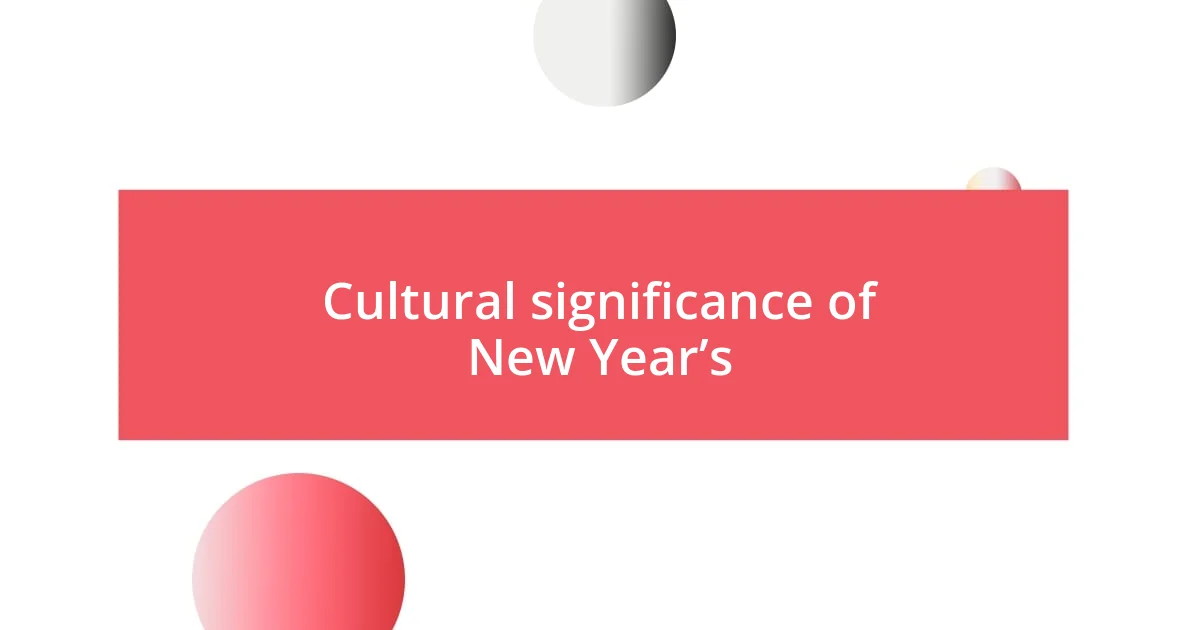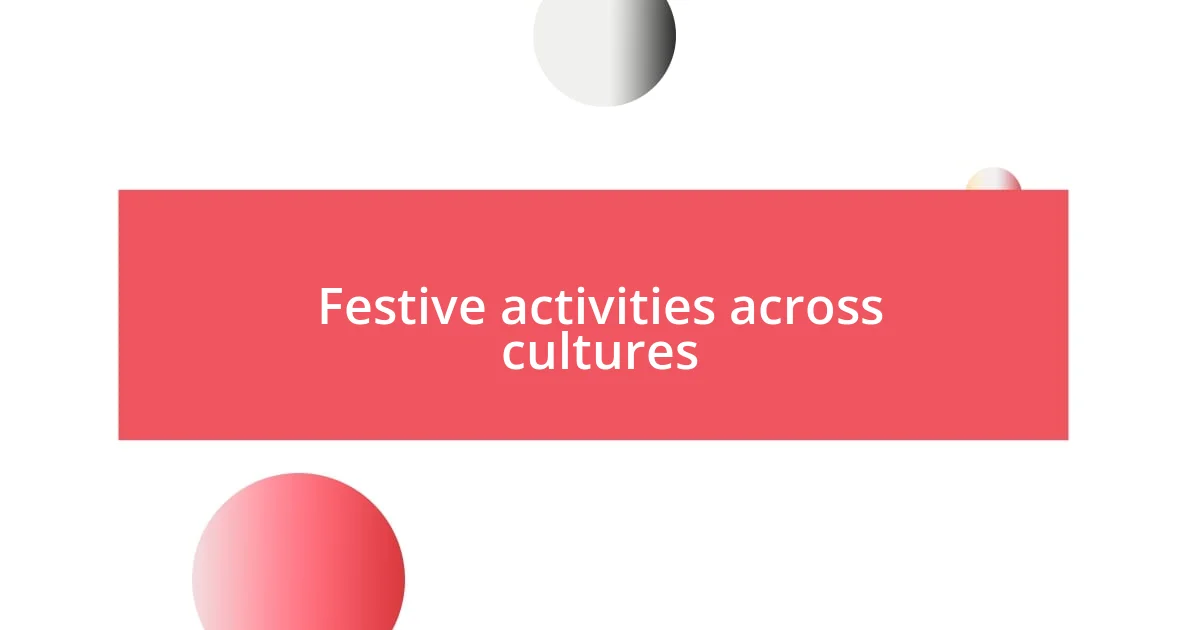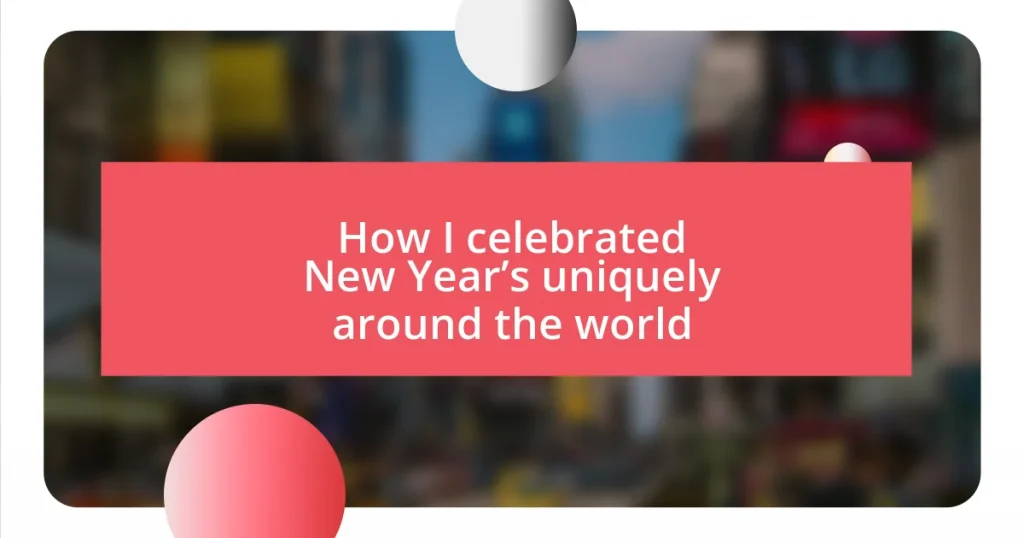Key takeaways:
- Experiencing New Year’s globally reveals diverse traditions, such as Japan’s serene temple celebrations and Ecuador’s cathartic effigy burning.
- Cultural significance is highlighted through customs that connect communities, like China’s family meals and Scotland’s Hogmanay hospitality.
- Personal experiences with New Year’s celebrations emphasize the power of shared rituals and traditions, fostering connections and reflections on hope for the future.

Unique New Year’s celebrations
Experiencing New Year’s in Japan was a revelation for me. The blend of tradition and festivity is mesmerizing. I remember standing in a silent temple as the clock struck midnight, listening to the 108 bell chimes—a custom believed to cleanse the soul of its sins. Have you ever felt such profound serenity amidst the excitement of a holiday?
In contrast, my time in Ecuador was vibrant and explosive! As the midnight hour approached, people gathered in the streets to burn effigies known as “Año Viejo.” It was fascinating to see how each effigy represented a year’s worth of experiences and bad memories. How cathartic it must feel to watch those flickering flames consume the past, right?
Another unforgettable celebration was in Spain, where I learned about the tradition of eating twelve grapes at midnight—one for each chime of the clock. The atmosphere was electric as everyone rushed to synchronize their grape-eating. In that moment, I couldn’t help but wonder: what hopes and desires were people secretly wishing for with each bite? The connection of food and festivity made it a truly memorable experience.

Cultural significance of New Year’s
The cultural significance of New Year’s celebrations varies greatly across the globe, yet each tradition echoes a universal desire for renewal and reflection. Personally, I’ve always found it fascinating how New Year’s serves as a canvas for cultural identities, embedding unique customs that resonate deeply with history and communal values. For instance, during my travels, I’ve seen communities use the New Year to pay homage to ancestors, reinforcing bonds between generations.
Here are a few ways different cultures celebrate the New Year, reflecting their unique significance:
- In China, the Lunar New Year is a time to honor family, featuring elaborate meals and ceremonies that emphasize togetherness.
- In Scotland, “Hogmanay” isn’t just a celebration of the New Year but also a way to embrace the spirit of hospitality and reconciliation.
- In India, the “Diwali” festival marks the New Year for many, symbolizing the triumph of light over darkness and good over evil.
- In Brazil, people dress in white and head to the beach to honor the sea goddess Yemanjá, weaving spiritual connection into festivity.
Each of these traditions encapsulates a rich cultural narrative, showing how profoundly the New Year is rooted in personal and communal reflection.

Popular customs worldwide
The customs surrounding New Year’s celebrations around the world truly highlight the diversity of human experience. During my travels in Greece, I was captivated by the tradition of slicing the “Vasilopita,” a cake baked with a hidden coin inside. The excitement in the air would rise as everyone eagerly anticipated who would find the coin, believed to bring good luck for the year ahead. I distinctly recall the moment the coin was discovered; the joy and cheers that erupted felt contagious.
In Italy, I had the pleasure of participating in “La Festa di San Silvestro,” where it is customary to wear red underwear for good luck in the coming year. It seemed amusingly quirky, yet it also imbued the evening with a sense of shared hope and playfulness. There’s something unifying about such peculiar traditions that brings people together, don’t you think?
Similarly, when I was in South Africa, I experienced a unique custom called “Second New Year’s,” where locals would gather for a massive street party on January 2nd. The vivid costumes, live music, and dancing created an atmosphere bursting with energy and excitement. I was so moved by how this celebration allowed the community to come together, fostering connections and friendships, amplifying the spirit of new beginnings.
| Country | Custom |
|---|---|
| Greece | Slicing the Vasilopita for good luck |
| Italy | Wearing red underwear for luck |
| South Africa | Celebrating Second New Year’s with street parties |

Traditional foods for New Year’s
When I think of traditional New Year’s foods, one dish that stands out is the “twelve grapes” custom in Spain. As the clock strikes midnight, people eat one grape for each chime, making a wish with every bite. I remember my first time trying this; the energy in the room was electric, and biting into those grapes felt like tasting hope for the future. It’s a delightful way to embrace the potential of a fresh start, don’t you think?
In Japan, the New Year brings a beautiful array of dishes known as “osechi-ryori.” Each element of this colorful feast symbolizes good fortune and prosperity for the year ahead. I once shared an osechi meal with a Japanese family, and I was struck by the meticulous layers of flavors and textures. It turned our dinner into a vibrant tapestry of meaning, where every bite narrated a story of aspirations and traditions. It was an experience filled with warmth and camaraderie, highlighting how food acts as a bridge between generations.
I can’t forget the rich lentil soup typical in Italy, particularly served on New Year’s Day. The lentils are said to resemble coins, symbolizing wealth and prosperity in the coming year. I vividly recall sitting at a cozy table in a rustic Italian kitchen, the fragrant aroma wafting through the air as laughter filled the room. It was more than just a meal; it was a ritual, a promise of good fortune, and an invitation to share in each other’s hopes. Isn’t it incredible how traditional foods can transform a simple occasion into something profoundly meaningful?

Festive activities across cultures
In Brazil, I found myself swept up in the magical New Year’s Eve celebration on Copacabana Beach. People dressed in white, symbolizing peace and renewal, danced under the stars as waves crashed around them. I joined in the joyful chaos, tossing flowers into the ocean as offerings to Yemanja, the goddess of the sea. It made me reflect on the universal hope for a fresh start, don’t you think?
Another memorable experience was during New Year’s in Denmark, where the tradition of jumping off chairs at midnight is common. Feeling slightly ridiculous, I followed suit with locals, and the laughter that erupted was infectious. It vividly demonstrated how a light-hearted act can bring people together, creating a shared moment of joy that marks the transition into the new year.
Then there was my enchanting evening in Mexico City, where families gather to celebrate the New Year with firework displays. I was invited to a local home where they had a unique tradition of burning an effigy known as “El Año Viejo” to say goodbye to the past year. Watching the effigy go up in flames was cathartic and exhilarating, almost like cleansing their spirits for the new year. Do you ever think about how powerful these rituals are in helping us let go of the past and embrace the future?

Personal experiences of celebration
Experiencing New Year’s Eve in Scotland was a revelation for me. I enjoyed a tradition called “Hogmanay,” where the streets filled with laughter and music as everyone exchanged gifts of coal, symbolizing warmth and hospitality for the year ahead. I remember standing in the middle of the street, surrounded by cheerful faces, and feeling a profound sense of community. Have you ever felt such warmth among strangers on a special night?
Another memorable celebration happened in the Philippines, where New Year’s is not just a night of revelry but a vibrant burst of sounds and colors. I joined a local family as they set off fireworks, while every corner of the street erupted into laughter and excitement. The night was filled with the rhythmic beating of pots and pans to drive away bad spirits. Experiencing this shared joy made me realize how noise can create a shared sense of hope and enthusiasm. Isn’t it amazing how different cultures use sound to welcome the New Year?
Reflecting on my time in India for New Year’s, the energy was electric as people lit lamps and set off colorful fireworks. I was invited to a local street party, where we danced together to the vibrant beats of traditional music, laughing and celebrating the first moments of the new year. I vividly remember the warmth of the bonfire as we made new friendships and shared hopes for the future. It’s interesting how these collective moments shape our long-lasting connections, don’t you think?

Tips for unique celebration ideas
When thinking about unique celebration ideas, consider creating a themed dinner party that reflects a culture far from your own. I once hosted a night inspired by traditions from Japan, complete with sushi-making and tea ceremonies. The laughter around the table—attempting to wrap sushi rolls—reminded me how food can beautifully bridge cultural gaps. Have you ever noticed how sharing meals can spark genuine connection?
Another idea is to host a storytelling night, where friends share their most memorable New Year’s experiences from around the globe. I tried this with a group of friends last year, and the tales of different customs, from fireworks to quiet family dinners, revealed the rich tapestry of human experience. It turned out to be a fantastic blend of nostalgia and laughter, creating a warm atmosphere that strengthened our bonds. Isn’t it fascinating how stories can transport us, making the ordinary feel extraordinary?
For something more adventurous, why not organize a midnight hike to welcome the New Year with nature? I had a thrilling experience hiking up a local hill with friends as the clock struck twelve, watching the city lights flicker beneath us. There’s something incredibly refreshing about starting the year in fresh air, surrounded by friends, where even the silence feels sacred. Have you ever felt the exhilaration of embracing the new year in a way that’s out of the ordinary?















